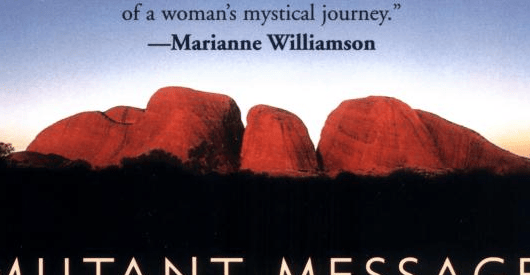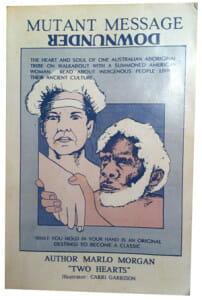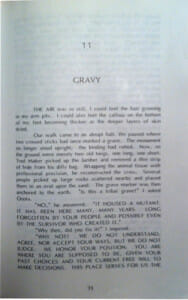
Back in the early 1990s, when “new age” centers were sprouting like magic mushrooms, and there was more “ancient” knowledge being revealed than would seem to fit into the entire ancient world, sensational stories came and went.
But if you were tuned into that world, you would have heard strange stories about a woman who had been where no white woman had been before, and brought back the secrets of the Aboriginal tribes of Australia.
The wave of interest and rumors was set off by Marlo Morgan, an American writer with a sensational story to tell. In 1991 she self-published her tale of indigenous wisdom and magic under the title Mutant Message Down Under.
Self-Publishing an Ancient Wisdom Adventure Tale
The book told the story of Morgan’s travels to Australia and meeting with a mysterious tribe of Aborigines, who strip her of all her possessions and take her on a “walkabout” into the outback for months.
The author describes the amazing powers of the apparently primitive tribe, their ability with telepathy, with using plants to perform miraculous feats of healing, of their attachment to and understanding of the natural world.
Throughout the book Morgan takes a matter-of-fact journalistic approach to reporting her experiences. She learns to let go of her anxieties, to rely on her own intuition, and how connected she is to the natural world.
There’s a feeling of mystery and discovery in the book, and you come away with a genuine awe for the simple but apparently very deep and complex people who gave her this experience, as well as a newfound respect for the “oneness of all things.”
Spreading the Word
The book found an audience among the many spiritual seekers who responded viscerally to Marlo Morgan’s message of oneness, respect for the indigenous peoples, and the transcendent nature that we have within us.Sales exploded, and the little self-published book sold over 370,000 copies. It attracted the attention of HarperCollins who issued a 250,000-copy printing of the book in 1994. Mutant Message Down Under spent 31 weeks on the New York Times bestseller list. Eventually HarperCollins would go on to sell almost a million copies of the book.
This type of success for a self-published book is rare enough, but the story gets more interesting.
In Books, Things Are Not Always What They Seem
Eventually, the Aborigines themselves stepped into the picture. They denied that the author had any knowledge of Aboriginal culture, or any experience of them at all. The Dumbartung Aboriginal Organisation issued a report, after a thorough investigation:
They claim that Aboriginal groups believe Ms Morgan’s desert journey to be fabricated and that her book and teaching lack credibility. The Dumbartung Aboriginal Organisation stated that it was deeply offensive to Aboriginal people for a white woman to be misrepresenting Aboriginal culture for self-promotion and profit. Aboriginal people expressed anger that Ms Morgan’s false message is being accepted as fact by a naive American and European market and were extremely concerned about the resulting long term implications for their culture. (Wikipedia)
Eventually, a delegation came to the United States to confront the author, who apparently admitted that she had fabricated the whole story. But book buyers never heard that part of the message, and continued to buy the book in large numbers.
It didn’t stop others from piling on Ms. Morgan. Australians analyzed every part of her story and deduced that she had never visited Australia at all from the numerous errors in her book. Some people went so far as to criticize the book’s typography, claiming that setting the words “Down Under” upside down on the cover was in itself a slap in the face.
It Just Keeps Going
In 2004 HarperCollins issued a tenth-anniversary edition of the book, so we can assume it was still selling well. But the publisher seems schizophrenic when it comes to categorizing the book.
Since the factual nature of the book has been exposed as false, it’s listed as “fiction” in their catalog. But here’s some copy from their website, under a “Mutant Message Down Under Reading Guide”:
An American woman is summoned by a remote tribe of nomadic Aboriginals, who call themselves the “Real People,” to accompany them on a four-month long walkabout through the Outback. While traveling barefoot with them through 1,400 miles of rugged desert terrain, she learns a new way of life, including their methods of healing, based on the wisdom of their 50,000-year-old culture. Ultimately, she experiences a dramatic personal transformation. Mutant Message Down Under recounts a unique, timely, and powerful life-enhancing message for all humankind.
Doesn’t sound like a description of a novel, does it?
But the strangeness of this book and it’s publishing journey doesn’t stop there.
DIY Self-Publishing Defies Reason
The original self-published version of Mutant Message Down Under did not win any awards. In fact, the book is pretty much a disaster. There’s no credit to whoever printed it, but that’s probably a good thing.The book is set in san-serif type, but there are also sections set in a serif face. There’s no reason or explanation for why this might be, but the printing is so bad that readers may not notice that the faint, gray type switches designs here and there throughout the book.
It’s decorated with numerous “primitive” drawings by Carri Garrison, there are entire sections set in ALL CAPS, and apparently it was typeset on some kind of word processor, since there are double spaces between the sentences. Since there’s no hyphenation in the book, some of these spaces are truly large enough to hide a case of Foster’s lager. Reading it is a chore.
And yet the book was a runaway success. The copy I have has quotes on the back from Og Mandino, Elisabeth Kubler-Ross and Wayne Dyer, all world-famous figures even then. Here’s what Dyer had to say:
A powerful message for all of us. I was hypnotized by the simple truths and spiritual lessons. Read it and tell everyone you know to do the same.
I guess just about everyone followed that advice, and you can’t blame Dyer for being taken in, along with hundreds of thousands of other readers.
But I took a lesson away from this publishing phenomenon. Marlo Morgan had something, even if it wasn’t a strict adherence to the truth.
She could really tell a story, and be convincing. The book is personal and mesmerizing. It exerts a powerful pull on many people who read it. At its heart, the book appeals to a strong inner yearning for good, for believing in the magical properties of the world, it appeals to our desire that there be people with a way of knowing the world that’s completely different from our logic-driven way.
Here’s a comment from a reader on Amazon:
After completing the book and studying the controversy surrounding it, I was truly disappointed to learn that the real Aborigines are, apparently, nothing like the ones portrayed in the book, and their culture no more enduring than that of thousands of other cultures, now extinct. The Real People portrayed in the book are so much more interesting and worthy of admiration, IMHO.
I suspect this reader is not alone in preferring Ms. Morgan’s invented tribe to the Aborigines fighting to protect their culture. And that’s the most amazing thing about this book, in a way. Despite everything, it gives some readers a transcendent experience while they’re reading it. Carried clear away from our world to a simpler, more intuitive place, the author communicates her message of ecological and spiritual necessity in a way that hooks readers and won’t let them go.
When you can be so convincing that readers prefer your reality to the actual reality around them, that’s something. In the end, that might be the most remarkable part of this self-publishing journey.
All Amazon links are affiliate links. Thank you for your patronage.




